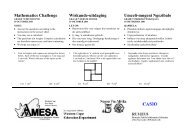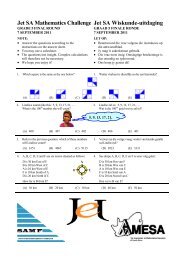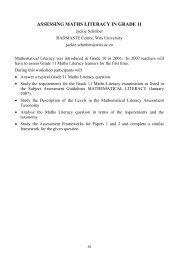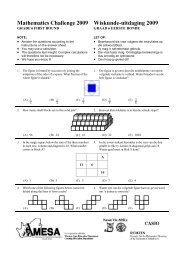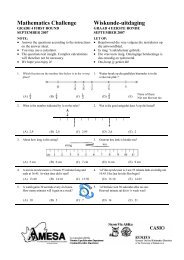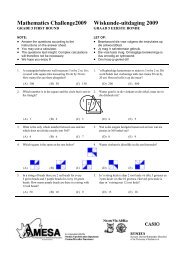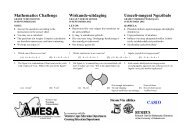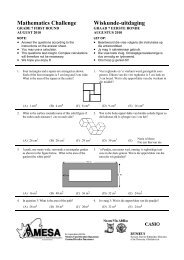- Page 1 and 2:
Proceedings of the15 th Annual Cong
- Page 3 and 4:
Foreword“Mathematical Knowledge f
- Page 5 and 6:
ContentsHow I teachAuthor Title Pag
- Page 7:
Scheiber, JackieThe interpretation
- Page 10 and 11:
SKETCHING A CUBIC FUNCTIONTRADITION
- Page 12 and 13:
of the first computer games, Pong,
- Page 14 and 15:
Although this genre of computer gam
- Page 16 and 17:
He played on and off all day until
- Page 18 and 19:
[10] Butgereit, L, “Thumb Tribe M
- Page 20 and 21:
2) Use the information given in the
- Page 22 and 23:
ConclusionSince these terms were fa
- Page 24 and 25:
EXAMPLE: The table below represents
- Page 26 and 27:
Five-number summaryMinimum = …; Q
- Page 28 and 29:
ACTIVITYIn an experiment to measure
- Page 30 and 31:
Conclusion:I hope that learners wou
- Page 32 and 33:
ACTIVITYBelow is a summary of a cir
- Page 34 and 35:
REFERENCESScheiber, J. 2003. Data h
- Page 36 and 37:
MOTIVATION FOR RUNNING WORKSHOPThis
- Page 38 and 39:
CONCLUSIONThese are not the only te
- Page 40 and 41:
n(E)• P(E) = 1 if event E is cert
- Page 42 and 43:
DETERMINING PROBABILITIES OF COMPOU
- Page 44 and 45:
Calculate the relative frequency of
- Page 46 and 47:
HOW I TEACH SCATTER PLOTSDUNGILE MA
- Page 48 and 49:
• It is clear from the above grap
- Page 50 and 51:
A STATISTICAL INVESTIGATION INTO HU
- Page 52 and 53:
• Does the activity relate to han
- Page 54 and 55:
MEASURES OF CENTRAL TENDENCYTHABANI
- Page 56 and 57:
1) Determine the mean, mode and med
- Page 58 and 59:
HOW I TEACH MATH USING VIRTUAL MANI
- Page 60 and 61:
The Balloon ModelIs this game fair?
- Page 62 and 63:
Virtual manipulatives can be both s
- Page 64 and 65:
References• Moyer P., Bolyard,J.
- Page 66 and 67:
WHAT ARE MISLEADING BAR GRAPHS?If a
- Page 68 and 69:
CONCLUSION:It is a well known fact
- Page 70 and 71:
MISLEADING AVERAGESThe mean, median
- Page 72 and 73:
e) Do you think any of the averages
- Page 74 and 75:
ANALYSIS OF QUESTION 10.2 OF THE NO
- Page 76 and 77:
CONCLUSIONThe midpoint curve is TRA
- Page 78 and 79:
called a sample. A sample is any su
- Page 80 and 81:
This demonstrates that the larger t
- Page 82 and 83:
Consider the marks 32 ; 56 ;With 32
- Page 84 and 85: SOLUTIONStep 1: Collect the data in
- Page 86 and 87: HOW I TEACH TALLY TABLES TO LEARNER
- Page 88 and 89: In a survey, 50 people were asked t
- Page 90 and 91: At the end of the first “branches
- Page 92 and 93: Let A denote an odd and even number
- Page 94 and 95: ADD THE ANGLE TO THE 2- and 3- DIME
- Page 96 and 97: ……………………………
- Page 98 and 99: Enlarge the following objects90
- Page 100 and 101: MathematicsGrade: 6Learning Outcome
- Page 102 and 103: A B CD E FGMathematicsGrade: 6Learn
- Page 104 and 105: INVESTIGATING 3-D SHAPES: ANALYSING
- Page 106 and 107: When we arrange objects according t
- Page 108 and 109: Sphere:Cube:Prisms, pyramids, cylin
- Page 110 and 111: a Now complete the table below:pris
- Page 112 and 113: 27 Now look at the different spatia
- Page 114 and 115: elationships algebraically; and rep
- Page 116 and 117: • How do analytical and global th
- Page 118 and 119: Adults must not be shy about asking
- Page 120 and 121: In fact, if a pupil asks a research
- Page 122 and 123: INVESTIGATING BALANCING POINTS OF P
- Page 124 and 125: DATA HANDLING IN THE FOUNDATION PHA
- Page 126 and 127: NUMERACY ASSESSMENT STANDARDS AND M
- Page 128 and 129: FUNCTIONS AND INVERSES IN CONTEXTMa
- Page 130 and 131: ARRIVE ALIVE!!!When a motorist brak
- Page 132 and 133: BACTERIA!!!Food goes rotten when th
- Page 136 and 137: REGRESSION MODELLINGPaul LaridonRAD
- Page 138 and 139: table. Then press [AC]. The screenc
- Page 140 and 141: 3.2 The PendulumThe diagram represe
- Page 142 and 143: 3.2.5 and comment on how good or ot
- Page 144 and 145: THE VERSATILE USE OF PATTERN BLOCKS
- Page 146 and 147: AN INTRODUCTION TO FUNCTIONAL RELAT
- Page 148 and 149: USE OF MATHEMATICAL GAMES AS AN ALT
- Page 150 and 151: the teacher’s ability to choose t
- Page 152 and 153: method. This will be followed by a
- Page 154 and 155: mathematical concepts, (2) develop
- Page 156 and 157: TEACHING AND ASSESSING SPACE AND SH
- Page 158 and 159: Grade R Grade 1 Grade 2 Grade 3•
- Page 160 and 161: 3.2Grade R Grade 1 Grade 2 Grade 3R
- Page 162 and 163: have a lid that can roll, andPeople
- Page 164 and 165: Grade R Grade 1 Grade 2 Grade 3•
- Page 166 and 167: 3.5Grade R Grade 1 Grade 2 Grade 3R
- Page 168 and 169: 3.6Grade R Grade 1 Grade 2 Grade 3R
- Page 170 and 171: WORKSHOP: TWO HOURSTARGET GROUP: GR
- Page 172 and 173: PROBLEM SOLVINGFOUNDATION PHASE MAT
- Page 174 and 175: 5. Guess the number I stand for.•
- Page 176 and 177: ASTROS? OR SMARTIES? ASTROS? OR SMA
- Page 178 and 179: It is important to note that volume
- Page 180 and 181: Part 1: The Great Bicycle Race (30
- Page 182 and 183: IDEAS AND ACTIVITIES TO MAKE YOU A
- Page 184 and 185:
WHAT IS THINKING? (15 MIN)An import
- Page 186 and 187:
EXPLORING GRAPHS THROUGH TABLESDORY
- Page 188 and 189:
• Use the constant -3 to decide o
- Page 190 and 191:
Explain the error in line 7.6. Draw
- Page 192 and 193:
SOLVING EQUATIONS & FACTORISING AN
- Page 194 and 195:
Simple GrowthYear Amount1 R11000234
- Page 196 and 197:
3. Solve for x :3 24x - 4x - 7x - 2
- Page 198 and 199:
2) QUARTILESA quartile is any of th
- Page 200 and 201:
‣ The lower quartile corresponds
- Page 202 and 203:
ACTIVITY:Answer the following quest
- Page 204 and 205:
SETTING A MATHS LITERACY EXAMINATIO
- Page 206 and 207:
are soup tins usually cylindrical?.
- Page 208 and 209:
Part 4: 30 minutesIn groups: Make y
- Page 210 and 211:
DEVELOPING ALGEBRAIC THINKING IN TH
- Page 212 and 213:
WORKSHEET 2Activities to develop le
- Page 214 and 215:
3.Fig. 1 Fig. 2 Fig. 34.Fig. 1 Fig.
- Page 216 and 217:
2. Another brick wall:Repeat questi
- Page 218 and 219:
2.1 Are the methods of all three le
- Page 220 and 221:
2.3 Is there an opportunity here to
- Page 222 and 223:
1.3 Is there an opportunity here to
- Page 224 and 225:
Investigate whether the following i
- Page 226 and 227:
Kieran, C. 1989. The early learning
- Page 228 and 229:
Motivation for doing the workshopOu
- Page 230 and 231:
• Paired cards• Crack the code
- Page 232 and 233:
• Separate tests were developed f
- Page 234 and 235:
Enlighten Education TrustBaseline T
- Page 236 and 237:
Enlighten Education TrustSchool Ave



